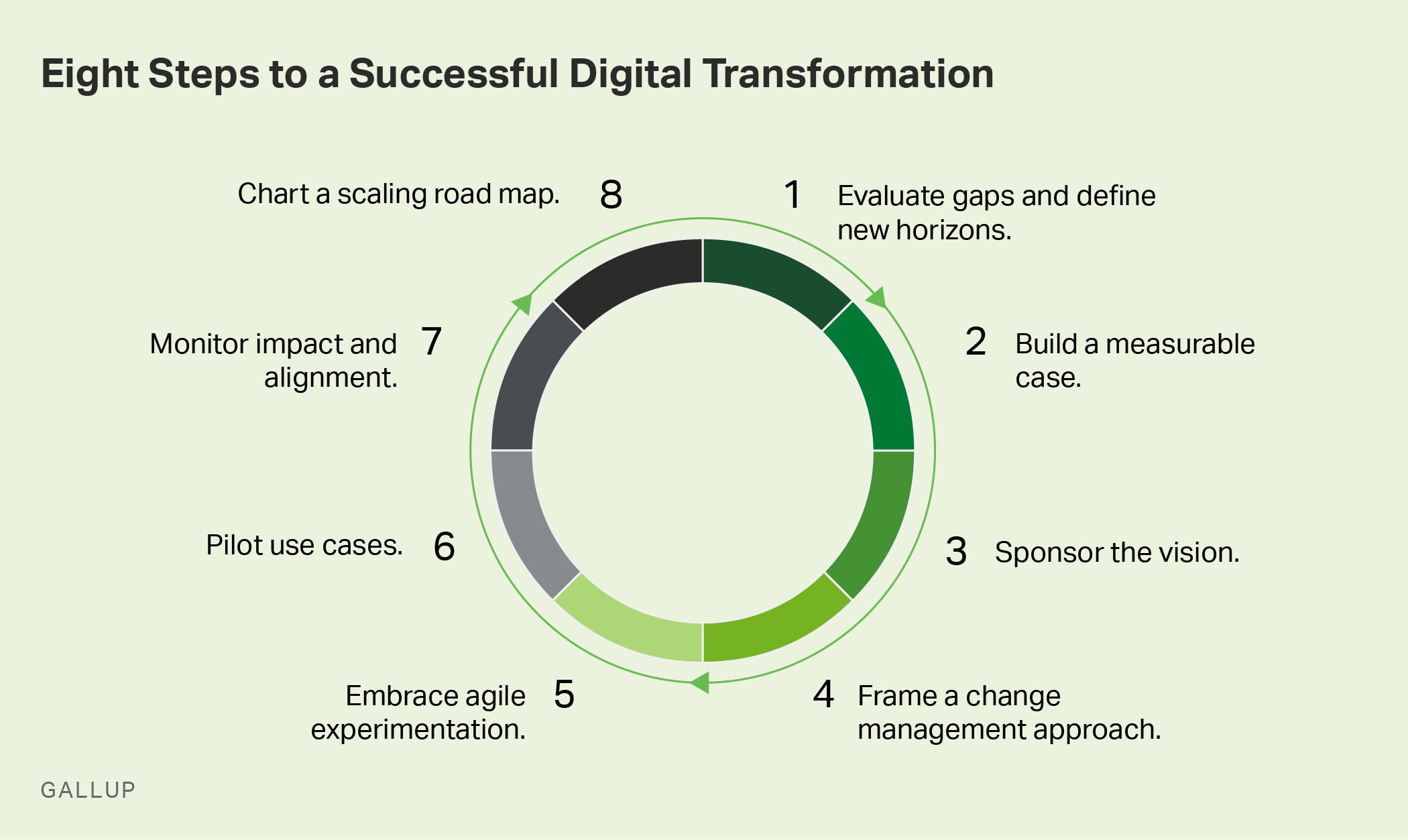Story Highlights
- Change management capabilities make or break digital transformation
- A great digital transformation strategy builds employee advocacy
- Make the most of agile methods
Digital transformation is probably the most substantial investment modern organizations are making. Multiple sources put global investments at several trillion dollars in upcoming years, and they expect that number to keep growing. When only 17 countries in the world have a GDP surpassing the trillion-dollar mark, that's a staggering investment -- and it's not paying off.
Only 17% of workers in the U.S. strongly agree that their company readily implements new technologies that help them be more productive, and Gallup's Real Future of Work study finds on average only 22.5% of employees in Spain, France, Germany and the U.K. strongly agree their company upskills them to make effective use of new digital technologies.
Without employee advocacy, the digital battle is lost upfront. But leaders can increase the odds of a successful digital transformation with eight strategic steps:

Image of a circle with the eight steps to a successful digital transformation written on the outside of the circle in a clockwise direction: 1) evaluate gaps and define new horizons, 2) build a measurable case, 3) sponsor the vision, 4) frame a change management approach, 5) embrace agile experimentation, 6) pilot use cases, 7) monitor impact and alignment, and 8) chart a scaling road map.
-
Evaluate gaps and define new horizons. Before embarking on a digital transformation, leaders should identify the most salient digital gaps in their company. Internally, they should address shortcomings and opportunities to execute the organization's strategy. Externally, benchmarking existing capabilities against competitors and industry standards will provide leaders perspective on what's next.
-
Build a measurable case. After evaluating the existing gaps, leaders need to shortlist the most critical opportunities to digitise their business model and select one or two initiatives to focus on. Aiming for multiple initiatives at once generates confusion and rarely yields any positive outcomes. The most digital-ready organisations have a committed C-suite that converts abstract opportunities into a few specific and measurable business cases with concrete timelines, meaningful KPIs and sufficient resources.
-
Sponsor the vision. Digital transformations often start strong at the top but lose momentum as they cascade to the frontline. Leaders need to convert business cases into an inspirational vision that resonates with the entire organization -- and role model it. Most leaders struggle to inspire; in fact, only 29% of employees worldwide strongly agree that their leaders make them enthusiastic about the future. If leaders fail to spark excitement, new digital initiatives will sputter as people resist change.
-
Frame a change management approach. Digital transformations often affect multiple areas in an organization or even the whole company. In the absence of a strong change management framework, inertia from the top will only confuse or misalign the departments it is meant to help. Gallup has identified seven principles for successful change management that leaders need to bear in mind when deploying any digital transformation initiative, starting by articulating a strong vision and being strategic about who to involve and when.
-
Embrace agile experimentation. To rapidly deploy a digital transformation initiative, agile methods offer a substantial advantage. First, they are collaborative in nature and can ensure different areas of the company -- and points of view -- are taken into consideration. Second, shorter sprints help identify impediments early on and allow for quick shifts in strategy.
-
Pilot use cases. Before committing more resources and implementing at scale, agile teams need to run short pilots to identify common success barriers, organisational strengths to lean on, and capabilities to build over time. Employees with a proven track record at leading new initiatives should have an early stake in ensuring the initiative can be scaled to the rest of the organization.
-
Monitor impact and alignment. During and after the rollout of pilots, leaders need to closely monitor the impact of the new technology on the business case and compare it with the external benchmarks and internal projections. The pilot's outcome should be coherent and consistent with the ultimate vision it is meant to bring to life. If it is not, leaders need to propose an alternate strategy to pilot before investing more resources to scale the initiative.
-
Chart a scaling road map. If leaders obtain enough insights to validate their most salient hypotheses and reduce risks to an acceptable level, they should proceed to scale the initiative. Implementing new technology -- regardless of its purpose -- at scale may represent an investment ranging from millions to billions of dollars. Such an investment requires a well-planned rollout strategy.
Building digital capabilities is one of the top priorities in executives' agendas -- and for good reason. It's not just resources at stake, but a company's ability to stay ahead and remain profitable in an increasingly competitive business world. Yet according to BCG, 70% of digital transformation initiatives fall short of their objectives. Often, their failure is a direct consequence of poor change management.
The most digital-ready organisations have a committed C-suite that converts abstract opportunities into a few specific and measurable business cases with concrete timelines, meaningful KPIs and sufficient resources.
Embracing a digital transformation is never easy, particularly in an era when technology continually reshapes the boundaries of what is possible. It's more difficult when most employees don't see the point or don't feel ready for it. And even more so when the investment fails. Leaders with a systematic approach to take advantage of new opportunities will win the battle of the future -- and see the investment pay off.
Digital transformation doesn't have to be an uphill battle:
- Learn how Gallup can help you get the right people, processes and structures in place.
- Develop employees who can effectively lead your transformation.
- Build a culture that promotes agility.




